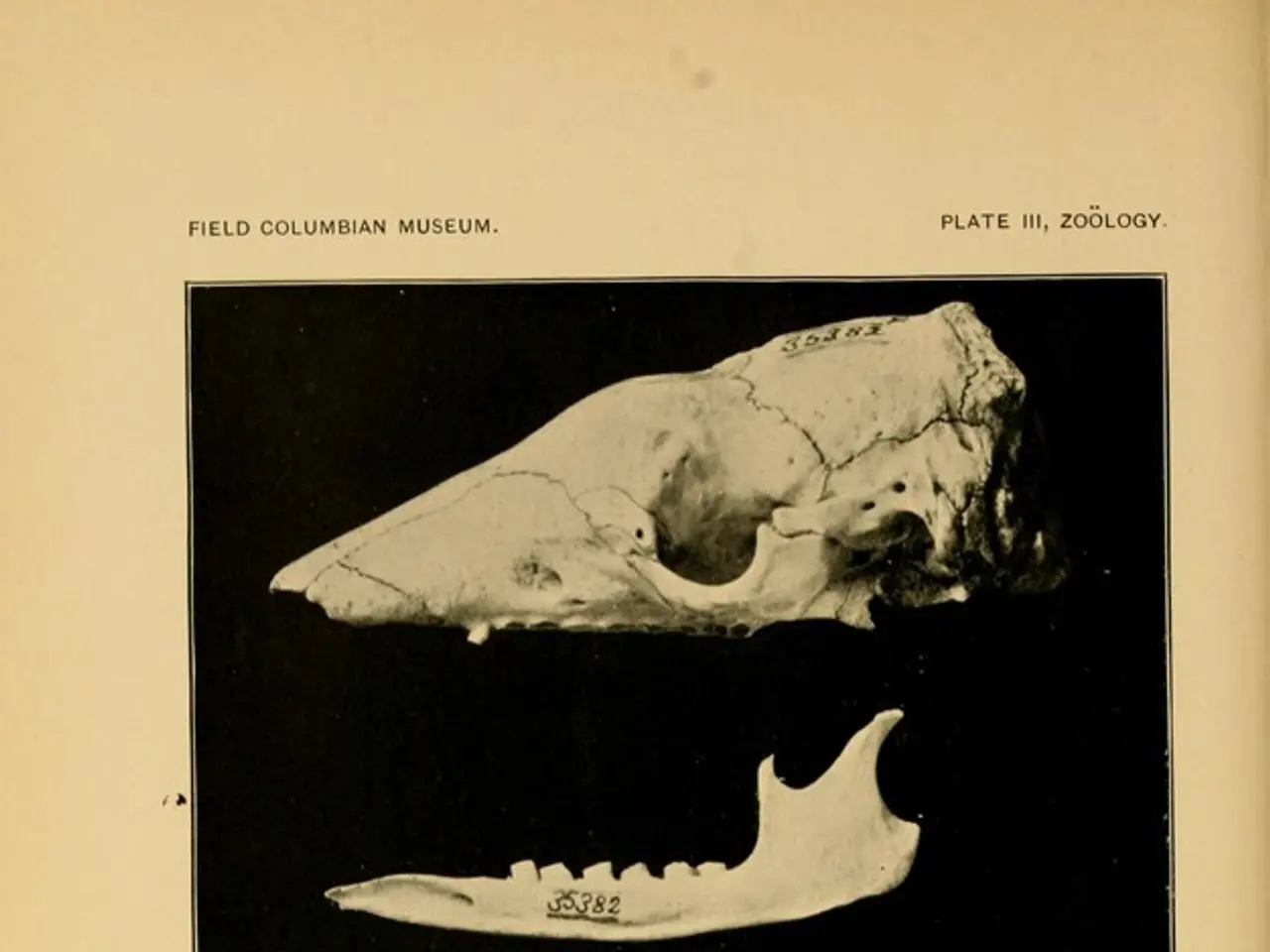Health Disorders Affecting Skeletal System: Kinds, Warning Signs, and Remedies
Bone diseases, particularly osteoporosis, can be a silent yet significant health concern. A combination of factors contributes to the development of these diseases, ranging from aging and hormonal changes to nutritional deficiencies, medical conditions, medications, and lifestyle factors.
Common Causes of Bone Diseases
Aging
As we grow older, our bone density naturally decreases, increasing the risk of fractures [2][3][4].
Hormonal Changes
Postmenopausal women experience estrogen deficiency, which accelerates bone loss, while low testosterone in men also contributes. Endocrine disorders such as Cushing syndrome, hyperparathyroidism, hyperthyroidism, hypogonadism, and diabetes mellitus also play a role [1][2][3][4].
Nutritional Deficiencies
Inadequate intake of calcium and vitamin D impairs bone strength and mineralization. Disorders affecting vitamin D absorption, like celiac disease, can also contribute to bone disease [1][2][3].
Medical Conditions
Chronic kidney disease, certain cancers, rheumatoid arthritis, central nervous system injuries, and liver disease can lead to bone loss via various mechanisms such as altered bone metabolism, inflammation, and immobilization [1][3][5].
Medications
Long-term use of certain medications, such as glucocorticoids, antiseizure medications, aromatase inhibitors, thyroid replacement therapy, heparin, proton pump inhibitors, anticoagulants (especially warfarin), and others, can induce secondary osteoporosis by affecting bone turnover or mineralization [1][3][5].
Immobilization and Reduced Physical Activity
Prolonged immobility, weightlessness, or conditions causing reduced weight-bearing activity contribute to decreased bone density [1][5].
Risk Factors for Bone Diseases
Lifestyle Factors
Smoking, excessive alcohol consumption, and sedentary behaviour negatively affect bone health and increase the risk of osteoporosis [2][3].
Secondary Osteoporosis
Conditions like COPD, hypercalciuria, hypophosphatemia, and use of certain substances can cause or accelerate osteoporosis [1].
Idiopathic Osteoporosis
Rare cases occur without known cause, affecting certain individuals such as premenopausal women, men under 50, and children with normal hormonal and vitamin D status [3].
In individuals with central nervous system injuries, bone loss is aggravated by reduced mobility, vitamin D deficiency, medication use, and nutritional deficits [5].
Overall, bone diseases result from an imbalance in bone formation and resorption influenced by these multiple intertwined factors [5].
It's crucial to maintain a healthy lifestyle, consume a balanced diet, and seek medical advice if experiencing symptoms or concerns related to bone health. Early detection and appropriate treatment can significantly reduce the risk of complications.
[1] National Osteoporosis Foundation. (2021). Medical Conditions that Increase the Risk of Osteoporosis. Retrieved from https://www.nof.org/patients/diseasefacts/medicalconditions/
[2] National Institutes of Health. (2021). Osteoporosis: Diagnosis and Treatment. Retrieved from https://www.niams.nih.gov/health-topics/osteoporosis/advanced
[3] Mayo Clinic. (2021). Osteoporosis: Symptoms and causes. Retrieved from https://www.mayoclinic.org/diseases-conditions/osteoporosis/symptoms-causes/syc-20354540
[4] World Health Organization. (2021). Osteoporosis. Retrieved from https://www.who.int/news-room/fact-sheets/detail/osteoporosis
[5] American Academy of Orthopaedic Surgeons. (2021). Bone Health: Fractures and Osteoporosis. Retrieved from https://orthoinfo.aaos.org/en/diseases--conditions/bone-health-fractures-and-osteoporosis/
- Aging is a natural cause that decreases bone density and increases the risk of fractures.
- Hormonal changes, such as estrogen deficiency in postmenopausal women and low testosterone in men, contribute to bone loss.
- Endocrine disorders, like Cushing syndrome, hyperparathyroidism, hyperthyroidism, hypogonadism, and diabetes mellitus, also play a role in bone diseases.
- Inadequate intake of calcium and vitamin D impairs bone strength and mineralization.
- Disorders affecting vitamin D absorption, such as celiac disease, can contribute to bone disease.
- Chronic kidney disease, certain cancers, rheumatoid arthritis, central nervous system injuries, and liver disease can lead to bone loss via altered bone metabolism, inflammation, and immobilization.
- Long-term use of certain medications, including glucocorticoids, antiseizure medications, aromatase inhibitors, and anticoagulants, can induce secondary osteoporosis.
- Prolonged immobility, weightlessness, or conditions causing reduced weight-bearing activity contribute to decreased bone density.
- Smoking, excessive alcohol consumption, and a sedentary lifestyle negatively affect bone health and increase the risk of osteoporosis.
- Conditions like COPD, hypercalciuria, hypophosphatemia, and use of certain substances can cause or accelerate osteoporosis.
- Rare cases of osteoporosis occur without known cause, affecting premenopausal women, men under 50, and children with normal hormonal and vitamin D status.
- In individuals with central nervous system injuries, bone loss is aggravated by reduced mobility, vitamin D deficiency, medication use, and nutritional deficits.
- Maintaining a healthy lifestyle, consuming a balanced diet, and seeking medical advice are key to early detection and appropriate treatment of bone diseases.
- Early detection and appropriate treatment can significantly reduce the risk of complications related to bone health.
- Predictive science can help identify individuals at risk for osteoporosis and other chronic diseases like diabetes, cancer, colitis, and eczema.
- Therapies and treatments, such as hormone replacement therapy, bisphosphonates, and denosumab, are available for the management of osteoporosis.
- Workplace-wellness programs can promote fitness and exercise, improve sleep, and address mental health concerns, contributing to overall health and wellness.
- Science continues to uncover connections between bone diseases, autoimmune disorders, neurological disorders, respiratory conditions, digestive health, eye health, hearing, and skin conditions.
- type 2 diabetes and depression are linked with an increased risk of osteoporosis, underscoring the importance of managing chronic diseases for bone health.
- Breast cancer and bone cancer share risk factors, such as estrogen levels and genetics, making it essential to monitor bone health in breast cancer survivors.
- Bipolar disorder, migraine, and sleep disorders may also impact bone health.
- Maintaining good nutrition, practicing skin care, and managing weight through programs like weight-management can contribute to overall bone health and wellness in men, women, and children, including those dealing with aging, parenting, and various medical conditions.




